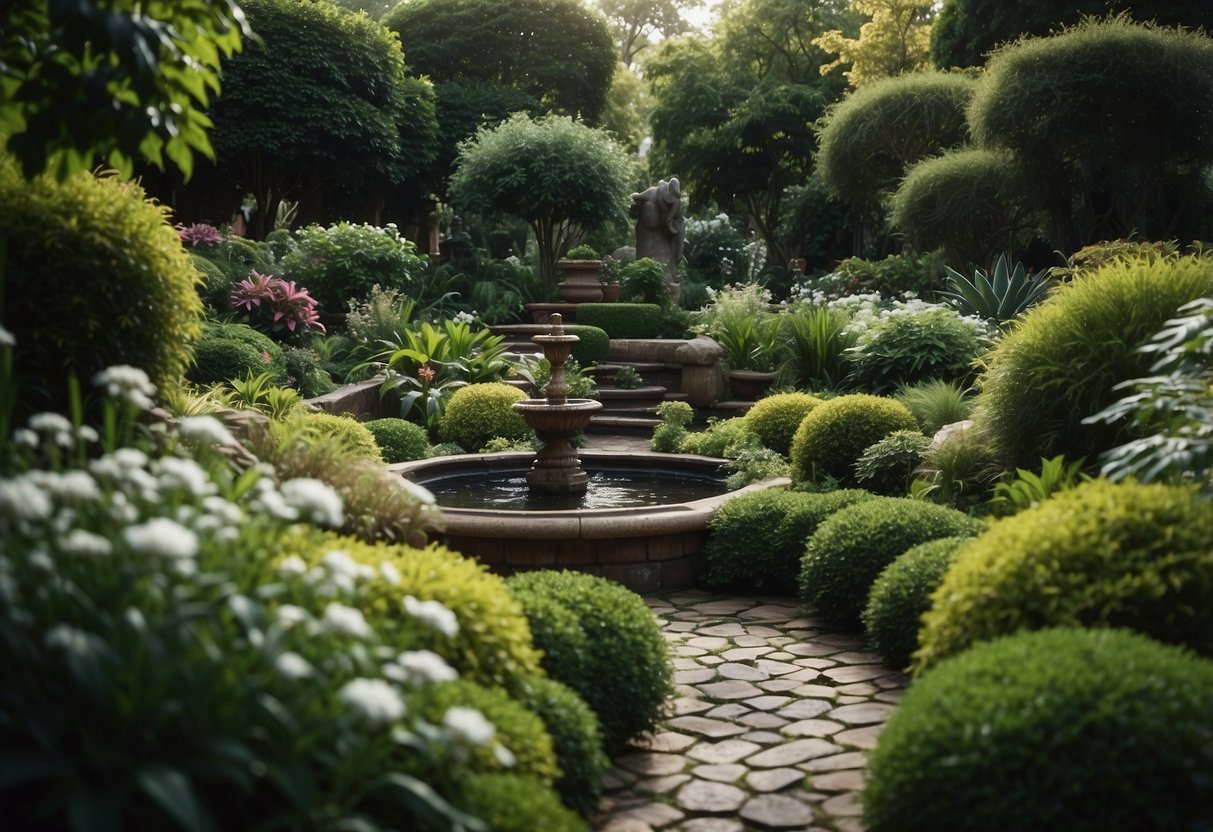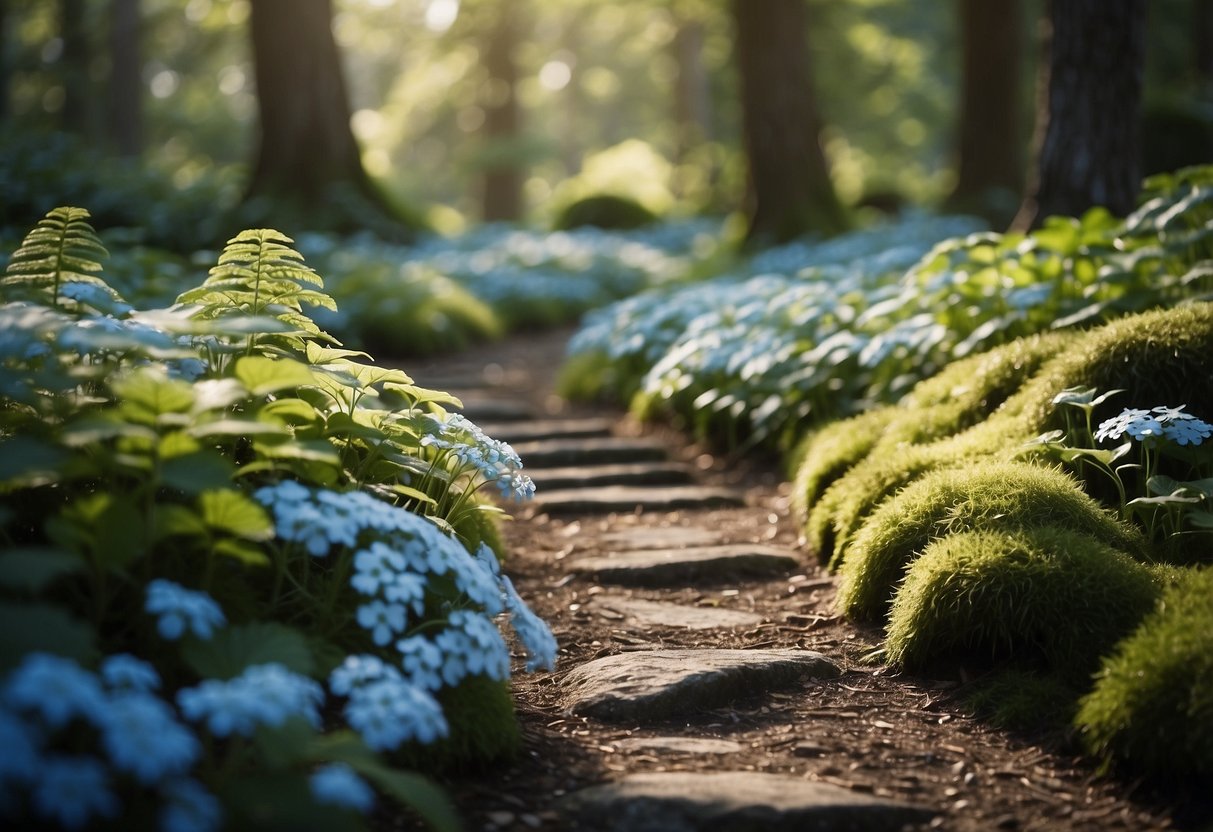No Sun Garden Ideas: Creative Tips for Shady Spots
Creating a garden where the sun doesn’t shine can be a delightful challenge. You can find plenty of plants that thrive in the shade, bringing life and color to those dim corners of your yard.

With a little creativity, you can transform any shaded area into a lush, vibrant space. Mixing plants with different textures and colors will add interest and beauty to your garden and ensure it looks full and diverse. Whether you’re looking to cultivate a peaceful retreat or a vibrant patch of nature, there’s a shade-loving plant out there for you.
1) Hosta Plants

Hosta plants are a great choice for gardens with little to no sun. They come in many sizes, shapes, and colors.
You can easily create a mix of texture and shades. Hostas are known for their lush foliage. Their leaves can be blue, green, gold, or variegated.
You can plant them in containers or directly in the ground. They thrive in shaded areas and are low-maintenance.
Learn more about hosta gardening from Proven Winners.
2) Ferns

Ferns are perfect for your shaded garden. They come in many shapes and sizes and thrive in low light. They don’t need much care and grow well in moist, well-draining soil.
The Lady Fern is a favorite due to its delicate, lacy fronds that reach up to 2 feet tall.
You might also love the Cinnamon Fern for its tall, reddish-brown fronds that add a unique touch. It’s hardy and can grow up to 5 feet tall.
3) Astilbe

Astilbe is a fantastic choice for a shaded garden. These plants thrive in areas with partial to full shade and produce beautiful, feathery flower plumes.
You can find varieties like Astilbe ‘Bridal Veil’, which have ivory-white blooms. Another great option is Astilbe ‘Dark Side of the Moon’ with its striking chocolate brown leaves and vibrant purple flowers.
Astilbe needs moist, well-draining soil to flourish. Plant them in the spring or fall for the best results.
4) Bleeding Heart

Bleeding Heart is a wonderful plant for your no-sun garden. It does well in partial to full shade. The plant features heart-shaped flowers that can brighten up any shady spot.
You should water it regularly, especially in its first year. During unseasonably dry periods, keep an eye on the soil and provide extra water if needed.
This plant can grow up to 30 inches tall, making it a charming addition to your garden. Its beauty and easy care make it a great choice for gardeners dealing with low light. Learn more about Bleeding Heart care.
5) Coral Bells

Coral Bells, also known as Heuchera, are a fantastic choice for your no-sun garden. They thrive in shade and come in a variety of colors, from deep purples to bright greens.
The compact, mounding form of Coral Bells makes them perfect for small spaces or container gardening. Their vibrant leaves can add a pop of color to any shady corner.
These plants are also easy to care for and require minimal maintenance. They can tolerate different soil types and are quite hardy. Consider pairing them with green hostas or ferns for a striking contrast. Find more information on Coral Bells.
6) Lily of the Valley

Lily of the Valley is perfect for a no sun garden. This plant thrives in shaded areas and adds a touch of elegance with its delicate white flowers.
Pair Lily of the Valley with ferns for a lush, green look. The combination gives your garden the feel of a serene forest glade.
Make sure your lily of the valley has neutral to slightly acidic soil. This helps it grow better and flower more beautifully. Your garden will look amazing with these low-maintenance plants.
7) Japanese Forest Grass

Japanese Forest Grass, also known as Hakonechloa macra, is perfect for shady gardens. It has bamboo-like stalks and a graceful, cascading habit, creating a lush, green carpet.
You can plant this grass in partial to full shade. It typically grows to about 18 inches in height. Space the plants 12 to 18 inches apart for the best coverage.
Add a layer of mulch around the base to retain moisture and keep weeds down. Water the plants to settle them into their new home. Check out more details on how to care for Japanese Forest Grass.
8) Foxglove

Foxgloves are a great choice for shaded areas in your garden. These tall, elegant plants can thrive in partial shade, making them perfect for spots with limited sunlight.
Plant foxgloves in well-draining soil. They do well in slightly acidic to neutral pH soils. Make sure to space them 12-18 inches apart for proper growth.
For a beautiful display, place foxgloves in the back of your garden beds. They add height and a splash of color, creating a stunning visual impact. Foxgloves are well-suited for zones 3-10. Read more about growing foxgloves at Homes & Gardens.
9) Brunnera

Brunnera, also known as Siberian Bugloss, is perfect for shady gardens. It has heart-shaped leaves that often feature beautiful silver markings. These plants grow to about 12-15 inches tall and can spread up to 2-3 feet wide.
Brunnera thrives in moist, well-drained soil and prefers cool garden areas. Blue flower clusters bloom in the spring, adding a lovely touch. Remember to water them regularly, especially during hot weather.
Plant them 12-14 inches apart to allow enough space for growth. Brunnera is hardy and will keep your shade garden looking great.
10) Hydrangeas

Hydrangeas are perfect for shady gardens. These beautiful blooms thrive without direct sunlight. They come in various colors like pink, blue, and white, adding vibrant hues to your garden.
Plant them with other shade-tolerant plants like hosta and heuchera. This combination creates a stunning look for patios and balconies. Keep them hydrated, giving them a deep soak weekly.
Enhance garden borders with hydrangeas and low-growing ornamental grasses like Blue Fescue. This pairing adds cool tones and creates a charming, serene space. Hydrangeas are a great choice for low-light gardening.
Understanding Low-Light Gardening

Low-light gardening revolves around selecting plants that thrive with minimal sunlight. This approach comes with unique benefits and challenges that can be managed with the right strategies.
Benefits of No Sun Gardens
No sun gardens can transform shaded spots into beautiful landscapes. Certain plants, like ferns, hostas, and columbines, thrive in these conditions. These plants often need less watering, reducing maintenance.
Shaded areas also provide a cooler environment, making them ideal for relaxing spots in your garden during hot days. You might be surprised to find that some vegetables, like lettuce and spinach, can also grow well in low-light environments.
Moreover, no sun gardens can feature beautiful textures and shades of green, creating an aesthetically pleasing and tranquil space.
Challenges and Solutions
Gardening in low-light areas does come with its set of challenges. Poor soil quality, such as compacted or dry soil, can be an issue. Adding compost or organic matter, like rotted leaves, can help improve soil structure and moisture retention.
Lack of sunlight means certain plants won’t perform well. Therefore, choose shade-loving plants like elephant ears, sweet potato vines, and alumroot. These plants are adapted to thrive without direct sunlight.
Managing pests can also be trickier in shaded areas. You might need to monitor closely and take measures like using natural pest repellents. Proper spacing and air circulation can help prevent mold and mildew from developing in these moist conditions.
Plant Selection for No Sun Gardens

When selecting plants for a garden that receives little to no sunlight, it’s important to choose varieties that thrive in shade. This includes not only decorative flowers but also vegetables and herbs that can grow without direct sunlight.
Shade-Tolerant Vegetables and Herbs
Growing vegetables and herbs in shaded areas can be rewarding. Some vegetables, like leafy greens, do particularly well in low-light environments. Spinach, kale, and arugula can thrive with just a few hours of indirect light each day. They are not only easy to grow but also very nutritious.
Herbs like parsley, cilantro, and chives are also great options for shady spots. They don’t require much sunlight and can add fresh flavors to your meals. Mint is another excellent choice; it spreads quickly and is easy to maintain.
To get the best results, make sure the soil is rich in organic matter. Adding compost can help the plants get the nutrients they need.
Best Flowers for Shady Areas
For a colorful garden even in the shade, consider planting flowers like hostas and coral bells. Hostas are known for their lush foliage and come in various shades of green, blue, and even white. Coral bells add bursts of color with their vibrant leaves, ranging from deep purple to bright orange.
Lungwort is another beautiful flower for shady gardens. It has lovely blue, pink, or white blooms and is very hardy. Hellebores, or “Lenten roses,” are also perfect for shade. They bloom in early spring and have delicate, nodding flowers in shades of white, pink, and maroon.
These plants not only survive but thrive in low-light conditions, making them excellent choices for shaded garden areas. Remember to keep the soil moist and well-drained to ensure the best growth.







